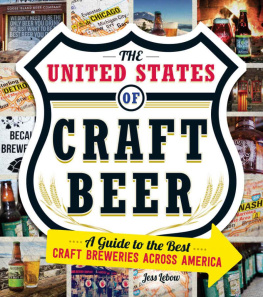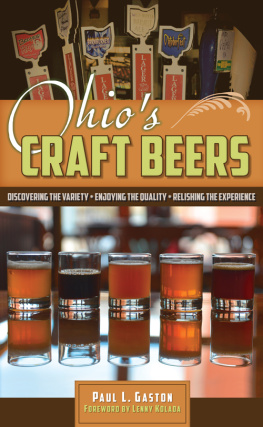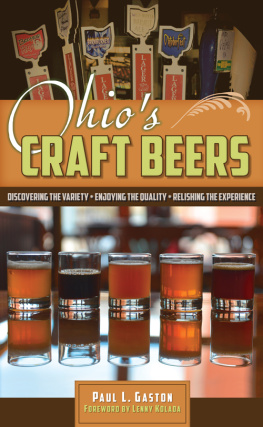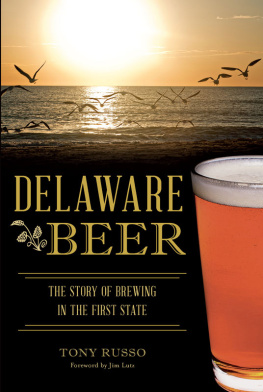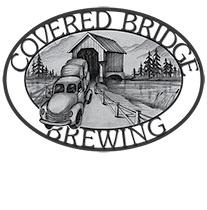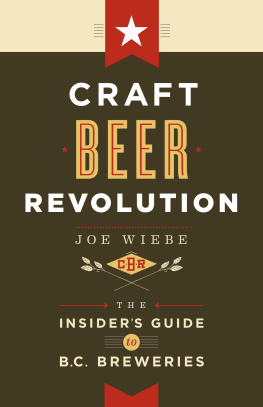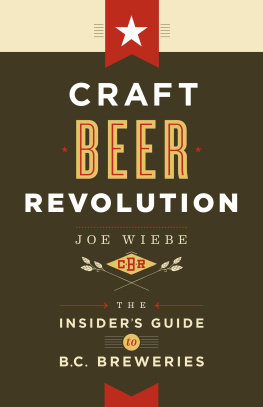THE UNITED
STATES OF
CRAFT
BEER
A GUIDE TO THE BEST CRAFT BREWERIES ACROSS AMERICA
Jess Lebow

AVON, MASSACHUSETTS
INTRODUCTION
Beer is truly an international beverage.
In ancient Egypt, beer was a form of sustenance, a bread-like liquid that could nourish the body and salve the soul. It was also a form of wealth. Workers were paid for their efforts with a daily ration of beer. Overseers, government functionaries, and elites were paid more than they could possibly drink, allowing them to in turn hire servants or trade their excess for other items of value.
In the 1400s in Germany, beer was such an important part of daily life that it sparked the creation of the oldest food law still in existencethe Reinheitsgebot. This ancient law, passed in 1487, lays out not only what can be put in beer but also set rules for the sale of beer and the cost of a liter of the stuff. Hundreds of years later, beers importance to German culture had not diminished, and it was with this frothy beverage in 1810 that wedding-goers toasted the marriage of Crown Prince Ludwig to Princess Teresathe very first Oktoberfest.
In the late 1800s and early 1900s in America, beer and its alcoholic brethren were considered the work of the devil, giving ammunition to the temperance movement that swept the nation and eventually led to one of the darkest periods in American historyProhibition and the Great Depression. In the 1930s, when Prohibition was ended by the Twenty-first Amendment, taxes on the revived beer industry helped pull the country, and eventually the world, out of their collective economic hole.
At the time of the American Revolution, before the bottle cap and before there was a distribution infrastructure, there were literally thousands of breweries in America. People bought their beer at their local taverns because it was difficult to package and transport beer very far, thus creating the need for so many breweries. During that dark, dark time of Prohibition, the number of breweries in America dropped to single digits, all of which turned to producing other products in order to survive.
Today, things have vastly improved, and we finally have more breweries in the country than we had during the Revolutionary War.
In the past few decades, there has been a renaissance in beer brewing in the United States. New flavors, new styles, and new breweries are popping up every day. Collaborations are taking placeoftentimes between brewers on opposite sides of the nation or even on different continents. Prospective brewers can attend universities dedicated to teaching the arts of craft brewing, and record numbers of students are graduating from these programs.
Though beer is brewed all over the world, and the origins of this beverage are far from the shores of this country, it is my belief that in no other place can you find such innovation, such craftsmanship, and such a wealth of good beer as is now in America.
This wasnt always the case. In the 1990s, if you traveled to Europe and offered to buy someone in France, Germany, Italy, or Belgium an American beer, you probably would have been laughed at. But thats only because the beer aficionados in those countries were unaware of the growing wave of craft brewing that had picked up momentum. Most of the rest of the world knew only of the big, commercially produced American beers. But times have changed. Information moves fast, and so do cans and bottles of beer. Though your local bottle shop may not stock all of the beers from all of the breweries in this book, many of them have found dedicated followings far from home. It is now possible to enjoy cold, craft-brewed American beers as far away as Shanghai, China, or even the remote islands of the Maldives. And while the joy of craft beers sometimes comes down to the fact that the beer in your pint glass can only be found at your local brewpub, I find it comforting that the American beer renaissance has spanned the globe and has finally put to rest the question of whether or not Americans can make good beer.
Jess Lebow
ALABAMA
Straight to Ale, Huntsville

ORIGIN
For the better part of the twentieth century, beer of 6% ABV or higher was illegal in the state of Alabama. Home brewing was also illegal in the state. In fact, it wasnt until the Gourmet Beer Bill was pushed through the state legislature in 2009 that breweries were allowed to raise the alcohol content of their beers up to a monstrous 13.9%. It took until May 2013 before Alabama finally became the forty-ninth state to legalize home brewing.
Of course, when the Eighteenth Amendment to the Constitution was enacted (1920), marking the start of Prohibition, one of the darkest stretches in modern American history, home brewing along with commercial brewing was made illegal in every corner of the nation. When Prohibition was repealed by the Twenty-first Amendment, thirteen years later (1933), brewers focused on returning commercial production to pre-Prohibition levelsnot only so that the thirsty masses could finally enjoy a bit of legal suds again, but also to help raise needed tax money that would eventually help lead the country and the rest of the world out of the Great Depression.

It might surprise you to know that it actually took another forty-five years (1978) before the laws governing home brewing began to catch up with those governing commercial breweries. And it took another forty-five years before Alabama home brewers would enjoy the same protections as the rest of the country.
What does all this have to do with Straight to Ale? Well, as you might expect, the founders of the brewery were themselves home brewers. They were active with brewing lobbyist groups like Free The Hops, groups that eventually managed to put enough pressure on the states government to get them to enact the laws allowing higher-alcohol beer and home brewers to peacefully coexist in Alabama.
So it was in 2009, on the Monday after the Gourmet Beer Bill was passed, that Dan Perry filled out the paperwork and began the process of creating Straight to Ale.
WHY WE LOVE THEM
Straight to Ale is the brewing equivalent of the boy who never wants to grow upthe adult who remembers what it means to play hard and have fun, who makes up the rules to a backyard game of hide-and-seek as he goes along to add just another little pinch of magic into a classic we all love. The companys beers are inventive and fun. Its named for cofounder Dan Perrys childhood memories of monkeys and dogs who were shot into space and dreams of becoming an astronaut.

The brewers take risks and try experimentslike aging their Russian imperial stout and saison in barrels previously used for tequila, rum, bourbon, and wine. Its this kind of thing that keeps bringing me back to the beer store. Its this kind of creativity that turns an afternoon of sipping beer from a just-having-a-cold-beverage experience into exploring the recesses of the human taste buds. Its this kind of beer that draws us to craft brews in the first placebecause they are different and dare to bring something new to the barbecue.

